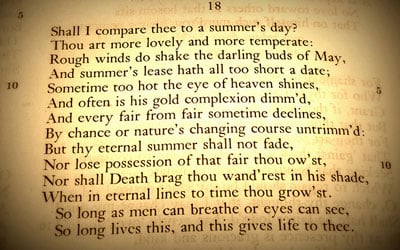How to write a sonnet
When writing a Shakespearean-style sonnet, there are various rules you need to keep in mind. This form of poetry is required to follow a specific format including length, rhythm, and rhyme scheme. To write a sonnet properly, follow this process:- Select a subject to write your poem about (Shakespearean sonnets are traditionally grounded as love poems).
- Write your lines in iambic pentameter (duh-DUH-duh-DUH-duh-DUH-duh-DUH-duh-DUH.
- Write in one of various standard rhyme schemes (Shakespearean, Petrarchan, or Spenserian).
- Format the sonnet using 3 quatrains followed by 1 couplet.
- Compose your sonnet as an argument that builds up as it moves from one metaphor to the next.
- Ensure your poem is exactly 14 lines.
The Shakespearean rhyme scheme
If you're writing the most familiar kind of sonnet, the Shakespearean, the rhyme scheme is as follows:A B A B
C D C D
E F E F
G G
Every A rhymes with every A, every B rhymes with every B, and so forth. You'll notice this type of sonnet consists of three quatrains (that is, four consecutive lines of verse that make up a stanza or division of lines in a poem) and one couplet (two consecutive rhyming lines of verse).
How a sonnet tells a story
Ah, but there's more to a sonnet than just the structure of it. A sonnet is also an argument — it builds up a certain way. And how it builds up is related to its metaphors and how it moves from one metaphor to the next. In a Shakespearean sonnet, the argument builds up like this:-
First quatrain: An exposition of the main theme and main metaphor.
-
Second quatrain: Theme and metaphor extended or complicated; often, some imaginative example is given.
-
Third quatrain: Peripeteia (a twist or conflict), often introduced by a "but" (very often leading off the ninth line).
-
Couplet: Summarizes and leaves the reader with a new, concluding image.
Shall I compare thee to a summer's day? Thou art more lovely and more temperate. Rough winds do shake the darling buds of May, And summer's lease hath all too short a date.
Sometime too hot the eye of heaven shines, And often is his gold complexion dimmed; And every fair from fair sometime declines, By chance, or nature's changing course, untrimmed;
But thy eternal summer shall not fade, Nor lose possession of that fair thou owest, Nor shall death brag thou wanderest in his shade, When in eternal lines to time thou growest.
So long as men can breathe or eyes can see, So long lives this, and this gives life to thee.The argument of Sonnet 18 goes like this:
-
First quatrain: Shakespeare establishes the theme of comparing "thou" (or "you") to a summer's day, and why to do so is a bad idea. The metaphor is made by comparing his beloved to summer itself.
-
Second quatrain: Shakespeare extends the theme, explaining why even the sun, supposed to be so great, gets obscured sometimes, and why everything that's beautiful decays from beauty sooner or later. He has shifted the metaphor: In the first quatrain, it was "summer" in general, and now he's comparing the sun and "every fair," every beautiful thing, to his beloved.
-
Third quatrain: Here the argument takes a big left turn with the familiar "But." Shakespeare says that the main reason he won't compare his beloved to summer is that summer dies — but she won't. He refers to the first two quatrains — her "eternal summer" won't fade, and she won't "lose possession" of the "fair" (the beauty) she possesses. So, he keeps the metaphors going, but in a different direction.
And for good measure, he throws in a negative version of all the sunshine in this poem — the "shade" of death, which, evidently, his beloved won't have to worry about.
-
Couplet: How is his beloved going to escape death? In Shakespeare's poetry, which will keep her alive as long as people breathe or see. This bold statement gives closure to the whole argument — it's a surprise.
Poets are attracted by the grace, concentration, and, yes, the sheer difficulty of sonnets. You may never write another sonnet in your life, but this exercise is more than just busywork. It does all the following:
-
Shows you how much you can pack into a short form.
-
Gives you practice with rhyme, meter, structure, metaphor, and argument.
-
Connects you with one of the oldest traditions in English poetry — one still vital today.


